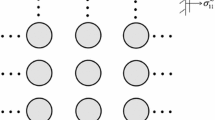Summary
We consider the macroscopic behavior of two-phase fibrous piezoelectric composites. The fibers are of circular cross-section with the same radius. Along the interfaces between the fibers and the matrix we consider the effects of surface stress and surface electric displacement. The constituents are transversely isotropic and exhibit pyroelectricity. We find that the overall thermoelectroelastic moduli of these solids must comply with two sets of exact connections. The first set, similar to Hill’s universal connections, provides five constraints between the six axisymmetric overall electroelastic moduli. The second set relates the effective coefficients of thermal stress and pyroelectric coefficients to the effective electroelastic moduli, in analogy with Levin’s formula. In contrast to their conventional counterparts, i.e., without surface effects, the presence of surface effects makes both sets of connections dependent on the absolute size of the nanoinclusions.
Similar content being viewed by others
References
Finn R. (1986). Equilibrium capillary surfaces. Springer, New York
Gibbs J. W. (1928). The collected works of J.W. Gibbs, vol. 1. Longmans, New York, 315
Allara D. L. (2005). A perspective on surfaces and interfaces. Nature 437: 638–639
Miller R. E. and Shenoy V. B. (2000). Size-dependent elastic properties of nanosized structural elements. Nanotechnology 11: 139–147
Gurtin, M. E., Murdoch, A. I.: A continuum theory of elastic material surfaces. Arch. Ration Mech. Anal. 57, 291–323 and 389–390 (1975).
Cammarata R. C. (1994). Surface and interface stress effects in thin films. Prog. Surf. Sci. 46: 1–38
Shuttleworth R. (1950). The surface tension of solids. Proc. Phys. Soc. A 63: 444–457
Nix W. D. and Gao H. (1998). An atomistic interpretation of interface stress. Scr. Mater. 39: 1653–1661
Freund L. B. and Suresh S. (2003). Thin film materials: stress, defect formation and surface evolution. Cambridge University Press, Cambridge
Sharma P., Ganti S. and Bhate N. (2003). Effect of surfaces on the size-dependent elastic state of nano-inhomogeneities. Appl. Phys. Lett. 82: 535–537
Chen T., Dvorak G. J. and Yu C. C. (2007). Size-dependent elastic properties of unidirectional nano-composites with interface stresses. Acta Mech. 188: 39–54
Fang Q. H. and Liu Y. W. (2006). Size-dependent interaction between an edge dislocation and a nanoscale inhomogeneitymwith interface effects. Acta Mater. 54: 4213–4220
Duan H. L., Yi X., Huang Z. P. and Wang J. (2007). A unified scheme for prediction of effective moduli of multiphase composites with interface effects. Part I: Theoretical framework. Mech. Mater. 39: 81–93
Mayes A. M. (2005). Nanocomposites. Softer at the boundary. Nature Mater. 4: 651–652
Weissmuller J. and Cahn J. W. (1997). Mean stresses in microstructures due to interface stresses: A generalization of a capillary equation for solids. Acta Mater. 45: 1899–1906
Zhou L. G. and Huang H. C. (2004). Are surfaces elastically softer or stiffer?. Appl. Phys. Lett. 84: 1940–1942
Huang, G. Y., Yu, S. W.: Effect of surface piezoelectricity on the electromechanical behaviour of a piezoelectric ring. Phys. Stat. Sol. (b) 243, R22–R24 (2006).
Friesen C., Dimitrov N., Cammarata R. C. and Sieradzki K. (2001). Surface stress and electrocapillarity of solid electrodes. Langmuir 17: 805–815
Michalski, P. J., Sai, N., Mele, E. J.: Continuum theory for nanotube piezoelectricity. Phys. Rev. Lett. 95, 116803(1–4) (2005).
Hill R. (1964). Theory of mechanical properties of fiber-strengthened materials: I. Elastic behavior. J. Mech. Phys. Solids 12: 199–212
Levin V. M. (1967). Thermal expansion coefficients of heterogeneous media. Mekhanika Tverdogo Tela 2: 88–94 (English version: Mechanics of Solids 2, 58)
Benveniste Y. (1993). Exact results in the micromechanics of fibrous piezoelectric composites exhibiting pyroelectricity. Proc. R Soc. Lond. A 441: 59–81
Chen, T., Dvorak, G. J.: Fibrous nanocomposites with interface stress: Hill’s and Levin’s connections for effective modul. Appl. Phys. Lett. 88, 211912(1–3) (2006).
Nye J. F. (1957). Physical properties of crystals: their representation by tensors and matrices. Clarendon Press, Oxford
Povstenko Y. Z. (1993). Theoretical investigation of phenomena caused by heterogeneous surface tension in solids. J. Mech. Phys. Solids 41: 1499–1514
Chen, T., Chiu, M. S., Weng, C. N.: Derivation of the generalized Young–Laplace equation of curved interfaces in nanoscaled solids. J. Appl. Phys. 100, 074308(1–5) (2006).
Milton G. W. (2002). The theory of composites. Cambridge University Press, Cambridge
Benveniste Y. and Dvorak G. J. (1992). Uniform field and universal relations in piezoelectric composites. J. Mech. Phys. Solids 40: 1295–1312
Dvorak G. J. (1990). On uniform fields in heterogeneous media. Proc. R Soc. A 431: 890–110
He Q. C. (1999). Uniform strain fields and microstructure-independent relations in non-linear elastic fibrous composites. J. Mech. Phys. Solids 47: 1781–1793
Chen T., Nan C. W. and Weng G. J. (2003). Exact connections between magnetostriction and effective elastic moduli of fibrous composites and polycrystals. J. Appl. Phys. 94: 491–495
Benveniste Y. and Miloh T. (2001). Imperfect soft and stiff interfaces in two-dimensional elasticity. Mech. Mater 33: 309–323
Author information
Authors and Affiliations
Corresponding author
Rights and permissions
About this article
Cite this article
Chen, T. Exact size-dependent connections between effective moduli of fibrous piezoelectric nanocomposites with interface effects. Acta Mech 196, 205–217 (2008). https://doi.org/10.1007/s00707-007-0477-1
Received:
Accepted:
Published:
Issue Date:
DOI: https://doi.org/10.1007/s00707-007-0477-1



